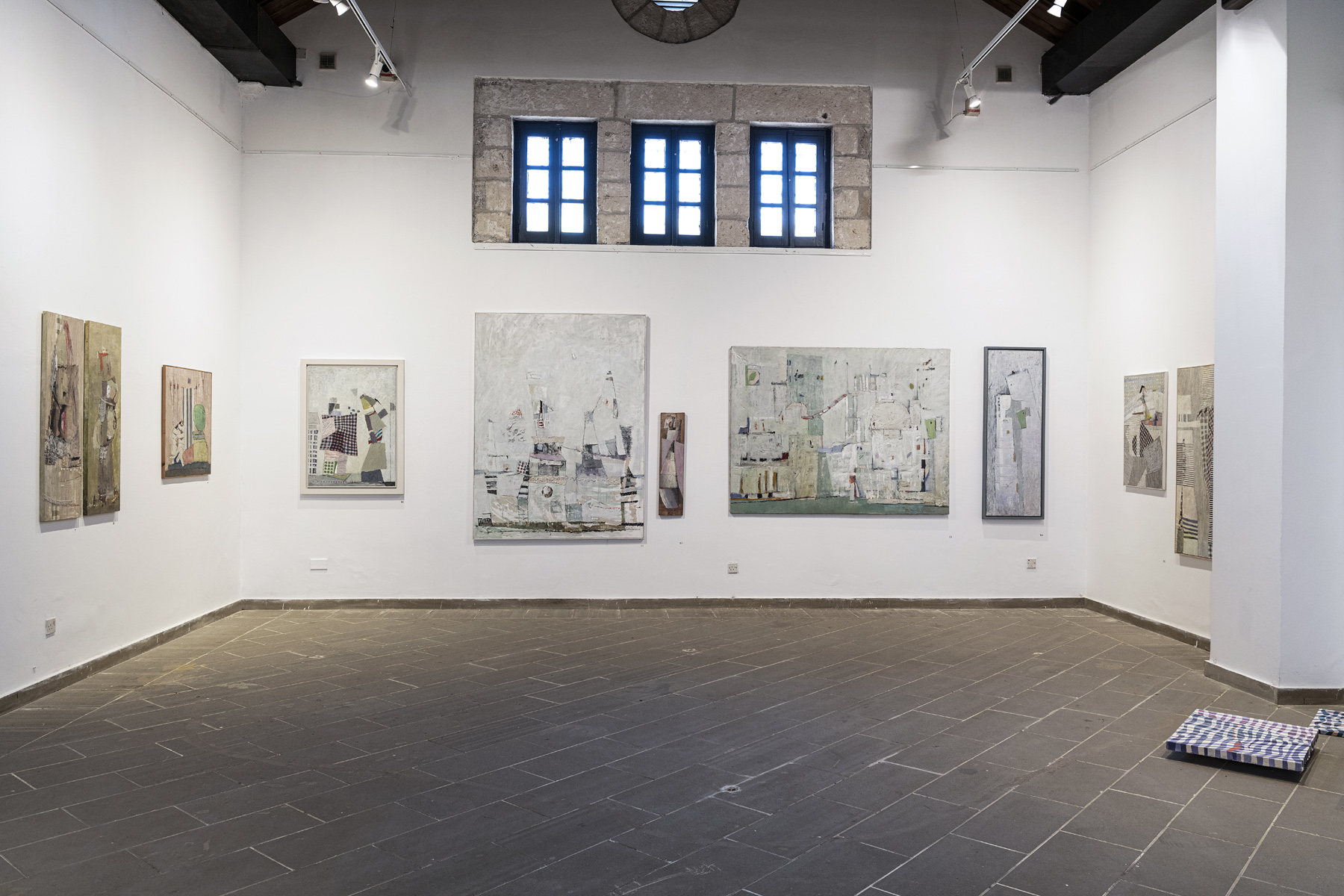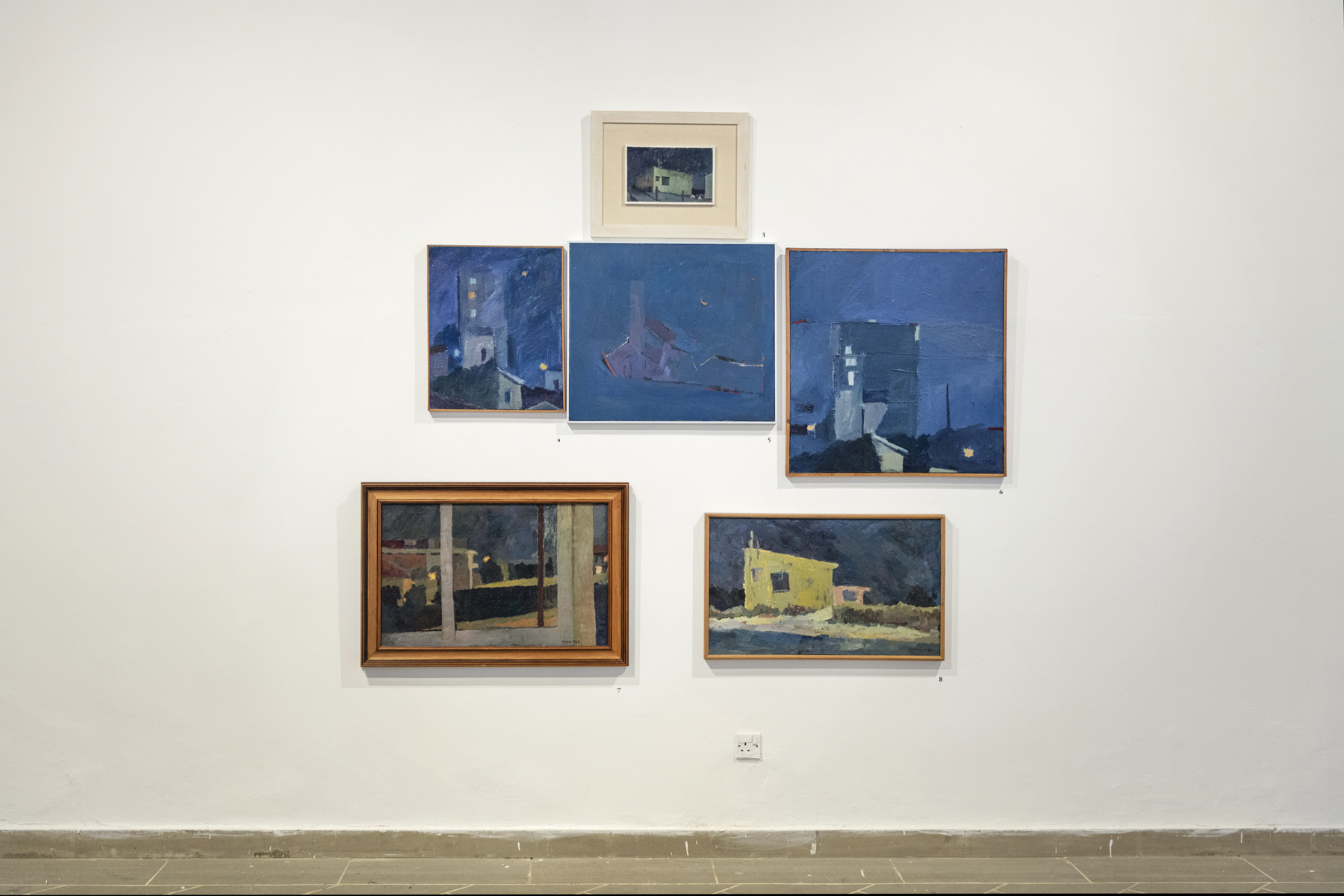





The exhibition When our Eyes Touch illustrates the scope of Nitsa Hadjigeorgiou’s (1949, Famagusta) oeuvre. By way of an interdisciplinary analysis of her practice, it explores a series of subjects deriving from and related to the creative process, while also highlighting the association between the social and the painting space.
Nitsa Hadjigeorgiou has been established as one of the most prominent figures in Cypriot Art. At the young age of 15, she already presented her first solo exhibition, encouraged by her teacher and painter Eleni Hariklidou. N. Hadjigeorgiou studied at Athens School of Fine Arts and her student years are marked by the Junta and the Athens Polytechnic Uprising in 1973, where her school was located. She has since been continuously and actively involved in the artistic and social sphere, while also working as an art teacher in secondary education.
Her diverse work has been presented in multiple solo and group exhibitions. Throughout her career, the artist represented Cyprus internationally, in participations like Biennale de Paris (1985), VII Triennale-India (1991), where works from the “Ecological Agony” series received top honours, Alexandria Biennale (1995).
In N. Hagigeorgiou’s practice is characterised by the simultaneous development of various series of heterogeneous works, which, in their entirety, form an intriguing amalgam of elements. The artist returns, in phases, to various dissimilarities, which are subject to a process of recovery, dealing with the perception of visual relations and the boundaries of the autonomy of painting.
Expressionism, abstraction and other references to the history of art, become tools for creating a visual semiotics, rendering faces and landscapes, suggestive anthropomorphic elements and abstract places, colour rhythms interwoven with the experience of music, employing rough materials that capture the qualities of light.
To approach the artist’s oeuvre, we enter an in-between mindscape where the sensory perceptions of sight and touch meet. Sight, just like hearing, receive stimulations from a certain distance. Touch, just like taste, are senses of proximity enabling us to recognize the qualities of the boundaries between bodies and objects. The interplay of these two senses leaves us exposed to a creative impulse where things may be preserved only if we look at them.
The experience of the non-batting of an eyelid when struggling to keep one’s eyes open upon touching them, is similar to the exchange of gazes that effectuate the circulation of other involuntary boundaries. In the absence of proximity, these boundaries lead to an ambiguity: “If two gazes come into contact, the one with the other, the question will always be whether they are stroking or striking each other – and where the difference would lie” as Jacques Derrida says in his essay When our Eyes Touch... The “touching of eyes” involves the interaction of the two senses with the one trying to shield itself from the other. It is suggested as a paradox defining the breaking point where the lack and presence of light becomes perceptible as a function of touch.
In view of the above, the exhibition When our eyes touch showcases the work of N. Hadjigeorgiou in four different sections (The Loving Gaze, Concern and Hope, Mythological Relations, Light: Movement and Repetition) constructed upon the enigma of the gaze that touches and is touched, in response to the coordinates of proximity and distance. It functions as an invitation, calling us to follow a different approach to things, as well as to maintain a position of openness, emphasising on a fragility that is sometimes “beautiful” and, at other times, “harsh”.”
The section titled The Loving Gaze presents works from the early painting period of Nitsa Hadjigeorgiou in a sequence that emphasises the different temporal and spatial situations within which she tries out the potentials of representation and the ekphrastic power of the brushstroke. Quick drawings are juxtaposed with academic studies in pencil and charcoal, as well as portraits, landscapes and still lifes – themes that showcase her dedication in understanding plastic laws as well as the sensual capturing of a completely poetic reality. Through experimentation mainly with earthy colour tones, and alternating between the studio and open air, she is driven in a freer depiction of her broader environment. The city’s intellectual, bohemian, and marginalized characters become her source of inspiration, whilst in works life Gyzi Square (1972) she is concerned with capturing movement.
The section Concern and Hope presents works in which Hadjigeorgiou approaches sensitive societal issues such as the ecological destruction, the consequences of the human reasoning putting limits and drawing boundaries on the map, the presence of a difficult past in the present time. In the works that make up the Ecological Agony series (1988 – 1991), the artist experiments with elements of abstraction to compose a ‘generic’ landscape, with elements from both the urban and the natural space. The colours and the clear forms she uses create images of a world in the midst of rapid change and reorganization. Through a serial approach, she creates different versions of the work which effect the feeling that each situation co-exists with the possibility of the contrary. In this way she is also communicating a message about a longed-for balance between humans with the rest of the planets’ ecology.
In the series of works with the general theme of Flags (1992), the artist puts more emphasis on the two-dimensional construct of the painting and splits the painterly surface into the shape of a cross. She incorporates materials like fabrics, and each piece of the composition suggestively alludes to natural and constructed environments, that co-exist in a sometimes familiar and sometimes unfamiliar balance. The in-between of familiarity and unfamiliarity also concerns the artist in the series Lefkaritika (2016). The gestural texture of the composition and the exogenous elements (lace) create a game of presence and absence within the composition’s order. The reference to the past meets the present sense of emergency.
The section Mythological Relations features works where Hadjigeorgiou creates a distinct visual vocabulary to approach matters of communication and relation. She uses shapes, volumes and motifs that create figures which refer to ancient geometric idols and are engaged in conversation, in a kiss or a caress. The colour palettes remind one of childhood innocence and the artist herself describes these works as “tender”. The fairy-tale like quality of these works is often supported by titles with mythological references. Characteristic examples are Dionysus and Ariadne (1999) and Aphrodite at a Dead End (2011). The same approach is used for imaginary landscapes to emerge. The geometrical relationships that arise through the “metaphorical shapes”, lead to the recognition of the landscape as an arena within which many heterogeneous elements communicate between them in ways that are not apparent to us in everyday experience.
In some of these works, her visual language becomes more sculptural, creating compact volumes that are tangent to one another. As a reference to a game of putting rocks on top of each other, trying to keep them in balance, the image transports us to a moment where the possibility and the avoidance of collapse coexists. In Mare Nostrum (2017 -2020), the schematic approach creates compositions characterised by repetitive patterns. The “outside” world is no longer depicted “within” the painting space, which results in the liberation of the painting process itself.
The section Light: Movement and Repetition brings together works from different periods, during which the artist deals with the light and its ability to become perceptible from different positions. In Doors and Windows (1982), the artist is located indoors, with the light entering from the outside into a dark room. In Nights (1981-89), we observe the light reflected on houses, which constitute the central subject of the painting, with the artist outdoors. The coldness of the urban landscape contradicts the warm light emitted from inside the houses. The power of chiaroscuro adds a borderline temporality. In the triptych Desire - Creation - Balance (1990), the composition is being deconstructed: space and time are not defined, while emphasis is put on the colour as a means of expressing a pure feeling. Biomorphic elements co-exist in free lines creating movement, while colour degradations attribute depth to the timeless horizon. In the works Salt Lakes (2010) and Lake (2010), we observe the evolution and transformation of her visual approach with regard to light, with bold brushstrokes capturing the degradation of light refraction onto water, as well as its continuous alternation.